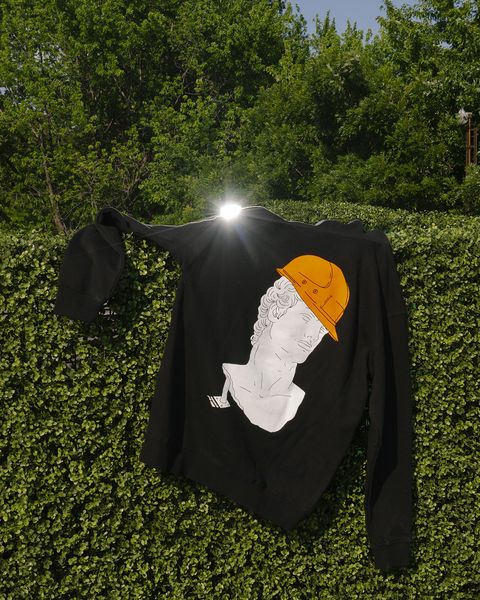Gay men are bilingual. Unlike most polyglots, however, a brother tongue isn’t always mastered during a year abroad in a place with cheaper rent and better food. It’s learnt on the job. Because, during countless eras of marginalisation, queer men had to communicate with a complex, clandestine lexicon of verbal and non-verbal cues to seek out like-minded others; men who were also hiding in plain sight. Bandanas in a specific colour hanging from a specific back pocket signalled certain kinks. Oscar Wilde’s green carnation became a covert signpost of queerness, and a seedling to the ‘pansy’ slur that followed. Even entire vernaculars were formed, like Polari, which fused Cockney and Romani to create a cryptolect that was exclusively tuned to the ears of gay men.
These days, in much of the West, safety exists beyond the shadows. But a second language of sorts is still used, even as technology democratises and digitises gay life; on Grindr, terms unfamiliar to the straights are exchanged in the quest for a hook-up (or perhaps something more). Similar words are cackled on Gay Twitter, and in the barbed judging process of RuPaul’s Drag Race. It’s also present in the top nav of Homoco, a menswear brand that is unreservedly queer in purpose, but not always in appearance. Click the drop-down menu and a double entendre makes it clear what’s on sale, and who’s buying it: ‘versatile tops’ and ‘power bottoms’. Or perhaps not so clear.
“I like the layers of sexual humour in the brand, but that’s not what the brand rests on,” says Daniel DuGoff, a voluble DC transplant in NYC, and Homoco’s founder. “It’s layered, and it’s more gratifying to me when people don’t necessarily think ‘that’s a gay brand’. Somebody who doesn’t get the joke of tops and bottoms can still take meaning from the product name. It’s a wink and a nod that lets us enjoy the brand in a way that a jockstrap with a dirty message on doesn’t. That is what it is. You get it. But with Homoco it’s like, ‘oh, that’s cool, why is there a gas station motif?’ Then you realise, oh it’s gay.” Homoco itself is shorthand for ‘Hommes Oil Company’, a remix of the original name of a chain of gas stations his family once owned.
DuGoff’s venture is indeed the end product of much layering. Like menswear decoupage, the designer has stacked elements of the past (his family’s), the professional (his architecture undergrad degree; his work with Marc Jacobs) and the future (his general style outlook), fastening it altogether in a label that’s part Alan Fletcher, part small town pumping station, and more than a little Boys In The Band. It sounds messy. But the designer didn’t pluck Homoco from the ether, nor is the illustrated oil can (a recurrent theme in the workwear-tinged clothing) without meaning.
The brand, with its baseball caps and easy-to-wear summer T-shirts, is actually on its second wind. “I never thought, ‘Homoco is going to be X’. I had one strand, and another strand, and another strand, and when they were put together, it was something different to my previous label,” says DuGoff, touching upon an eponymous menswear line that “wasn’t a failure but… never doing good enough to make sense”. It was a family joke that plaited all these ideas together. “We had a gas station chain that dissolved when I was a little kid, and it was called Homoco. There are all these queer people in my extended family and it’s this inside thing that we wink and nudge about but nobody’s done anything with it, and I thought all of these things I wanna do make sense if it was called Homoco.”
While dozens of gas stations operated under the name from the Thirties till the early Nineties, “nothing was properly registered beyond land use stuff” says DuGoff, and Homoco 2.0 is more a reference than a direct replication. “My grandmother owns everything, so I called her about the idea and she said great! I’m not sure how many layers of the onion she understood… but she was supportive. There was no designer or sign guy for the original Homoco, so we went through boxes of photos that belonged to her and scanned hundreds of shots of the old gas stations, and then the running prints of the oil was actually designed by my aunt and was framed in my parents’ house, so I took that, and went from there.” Though the family’s petrol pumps have long run dry, Homoco is still very much a family business; grandma even responds personally to the brand’s marketing email blasts. “She thinks they’re sent to her directly,” DuGoff says.
Bygone Americana is a clear reference in Homoco. It’s also a smart one. Where other trends swell and contract (maximalism; sportswear; #menswear of the mid Noughties), workwear has, more or less, become a wardrobe staple. Blue collar New England threads are now the uniform of choice for collars of all colours – which was DuGoff’s intentional all along with the foundation of a queer-adjacent unisex brand. “We talk about community instead of sex. There are all these naughty gay underwear brands that are like, kinda smut-driven? And then there are all of these super expensive luxury Mykonos gay brands that are just unattainable. If you’re going to take the full market of the entire population of consumers, but only talk to the richest white gay men in that group, or the ones who publicly advertise their sexual desires, you’re going after the tiniest per cent of customers versus building a brand that can speak to the widest range within a niche where we can still be community-driven.”
In a pre-Covid world, pop-up shops and trunk shows spread Homoco’s gospel, with DuGoff and his team travelling to gay vacation spots in America with a brand that subtly celebrated the community’s past. Summer T-shirts in the deepest shade of Atlantic blue bear the names of New York’s Hell’s Kitchen (“Don’t call it Midtown West” the back reads, in Studio 54 font), with other colours of the rainbow pinned to Provincetown in Massachusetts, New Jersey’s Asbury Park, Los Angeles, Palm Springs, and, of course, San Francisco, among others. “Those places, some of them are not as queer today as they used to be, but others are amazing spots that have these legacies of art and culture,” says DuGoff. “The more I dig into it, there are places all over that have these secret histories that are really fun to explore.”
Homoco, then, is continually rooting itself in the queer past while dressing for its future – though DuGoff mentions that he doesn’t think the product is revolutionary in and of itself. It’s easy to think otherwise. Never before has mainstream fashion been so unapologetically queer, from Calvin Klein jockstraps to ‘Daddy’ caps to a JW Anderson collab with the godfather of gay proto-porn, Tom of Finland (Homoco also released a crossover with the artist’s foundation last summer, which saw a designer This Is Amit reinterpret the Olympian physiques of Tom’s imagination). All of these things are no longer pushed to the fringes. Wearing a T-shirt emblazoned with Greenwich Village and the words ‘the birthplace of the modern queer rights movement’ is somewhat revolutionary, especially when, 40 years ago, declarations of queerness were whispered.
Many gay men are now out, and proud about it, and free and safe to wear a brand like Homoco that celebrates this fact. But DuGoff doesn’t forget those that made it possible. Alongside the T-shirts and baseball caps are a range of bandanas, brightly coloured, some printed with the shapely outlines of semi-naked men (the Tom of Finland collab) or burgundy cider cans (another partnership, with the bawdily named Stickett Inn hotel in upstate New York). “We live in a world where we don’t need these signifiers anymore,” says DuGoff. “Magazines would publish the hanky codes at the back so newbies could understand why green and yellow meant something totally different to green and white, and it’s a great place to remember queer history.” Because, although the language has changed, Homoco plays both etymologist and historian, celebrating the codes and the sanctuaries of the queer past, and thus commemorating the men who needed them most. Now, they’re no longer talking in secret.
Like this article? Sign up to our newsletter to get more delivered straight to your inbox
Need some positivity right now? Subscribe to Esquire now for a hit of style, fitness, culture and advice from the experts
This content is created and maintained by a third party, and imported onto this page to help users provide their email addresses. You may be able to find more information about this and similar content at piano.io












